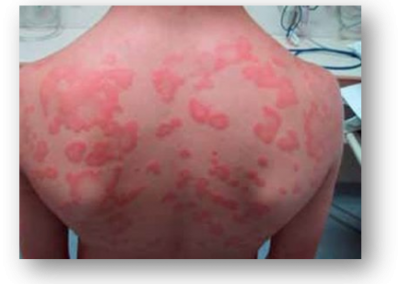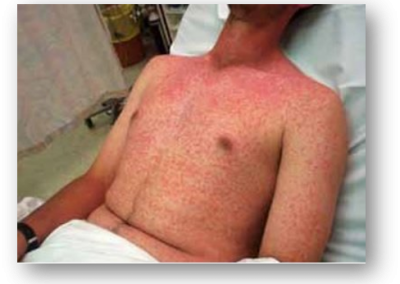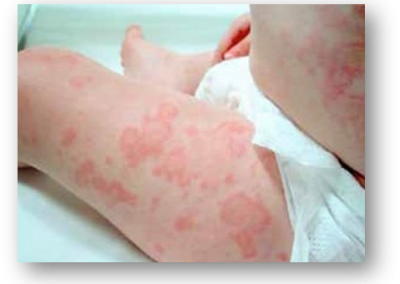FIRST AID ESSENTIALS
ALLERGY AND ANAPHYLAXIS
Anaphylaxis is the most severe form of allergic reaction and is potentially life threatening – it always requires an emergency response.
It must be treated as a medical emergency, requiring immediate treatment and urgent medical attention. Anaphylaxis is a generalised allergic reaction, which often involves more than one body system. A severe allergic reaction usually occurs within 20 minutes of exposure to the trigger. Severe allergic reactions may occur without prior exposure to a trigger. It is characterised by rapidly developing airway and/or breathing and/or circulation problems usually associated with swelling, redness or itching of the skin, eyes, nose, throat or mouth. Many substances can cause anaphylaxis but more common causes include:
- Foods (especially peanuts, tree nuts, cow’s milk, eggs, wheat, seafood, fish, soy, sesame)
- Drugs (e.g. penicillin)
- Venom from bites (ticks) or stings (e.g. bees, wasps or ants).
Signs and symptoms
Anaphylaxis encompasses a variety of symptoms and signs. Diagnosis is largely based on history and physical findings. Onset can range from minutes to hours of exposure to a substance. Symptoms and signs are highly variable and may include one or more of the following:
- Difficult / noisy breathing
- Wheeze or persistent cough
- Swelling of face and tongue
- Swelling / tightness in throat
- Difficulty talking and /or hoarse voice
- Persistent dizziness / loss of consciousness and / or collapse
- Pale and floppy (young children)
- Abdominal pain and vomiting
- Hives, welts and body redness.
This video is owned by © ALLERGY & ANAPHYLAXIS AUSTRALIA
Management
The injection of adrenaline (epinephrine) is the first line drug treatment in life threatening anaphylaxis. Adrenaline (epinephrine) autoinjectors are safe and effective management of anaphylaxis. People who have had a prior episode of anaphylaxis often have prescribed medication including adrenaline (epinephrine) in the form of an autoinjector and the early administration of adrenaline (epinephrine) is the priority in the emergency treatment.
If the victim’s symptoms and signs suggest anaphylaxis the following steps should be followed.
- Lay person flat – DO NOT allow them to stand or walk. If unconscious, place in recovery position. If breathing is difficult allow them to sit
- Give EpiPen® or EpiPen® Jr adrenaline autoinjector into upper outer thigh
- Phone ambulance – triple zero (000) (AU)
- Phone family/emergency contact
- Further adrenaline doses may be given if no response after 5 minutes
- Transfer person to hospital for at least 4 hours of observation
- If in doubt give adrenaline autoinjector
- Commence CPR at any time if the person is unresponsive and not breathing normally
NOTE: Further Epi-Pens can be administered to victims with severe anaphylaxis whose symptoms are not relieved by the initial dose -5 minutes after the initial dose.
Give asthma reliever for respiratory symptoms. *Most fatal cases of food-induced anaphylaxis occur in those with asthma. In patients with asthma known to be at risk from anaphylaxis, if it is uncertain whether the patient is suffering from asthma or anaphylaxis, it is appropriate to administer an adrenaline autoinjector first, followed by asthma reliever medication. No harm is likely to occur by doing so in a patient having asthma without anaphylaxis.
Adrenaline auto-injectors in Australia
EpiPen® or EpiPen® Jr are the only adrenaline auto-injectors available in Australia. Each EpiPen is a single dose of adrenaline.
The EpiPen® (yellow) is prescribed for children over 20kg and adults.
The EpiPen® Jr (green) is prescribed for children 7.5kg – 20kg.
Children less than 7.5 kg
Adrenaline autoinjectors are not usually recommended for children less than 7.5 kg as the risk of fatal anaphylaxis in children this age is very low. While the ‘optimal’ dose of adrenaline is unknown there is a risk that the lower dose adrenaline autoinjector could provide a significant overdose.

How to give an Epipen (adrenaline auto-injector)
This video is owned by © ALLERGY & ANAPHYLAXIS AUSTRALIA
Quick response guide





